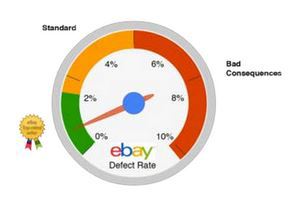Annual Review: What's new for eBay?

The kubish.ru cashback service continues to acquaint readers with sales experience on foreign sites. Last time we talked about how to sell products on Amazon, and today we will touch on the topic of innovations on one of the most popular platforms in the world - eBay.
2014 was a big year for eBay. Although many news headlines focused on the financial and structural separation of eBay and PayPal, and there is still speculation about the long-term implications, this should not have any impact on online sales.
')
For online commerce, 2014 is likely to be remembered as the year when eBay began its aggressive phase in increasing market share. This year, eBay has taken new steps towards its customers, both sellers and buyers.
These steps are primarily manifested in the introduction of a new metric - eBay Defect Rate (EDR, as it is called). We expect that this new “metric” will be very useful and implemented for many years. And it is not surprising that many of the notable changes of eBay released during the year were based on EDR.
If you are selling on eBay, most likely you have already met and interacted with EDR and we will give you more advanced information, if you are new to selling online - welcome to the world of eBay!
This article includes a lot of interesting things and can serve as a reference for planning a sales strategy in 2015.
Here we will discuss some other updates in online trading for 2014 on eBay.

SR 14.1: One metric controls everything
In 2014, the largest number of discussions among eBay sellers was focused on the new EDR, which was announced in March in release number SR 14.1
The percentage of EDR is based on this formula:
Number of defective transactions
___________________________
Number of transactions X 100 (to get interest)
For example, if you have 5,000 transactions per month on eBay, and if 10 of them were defective, then your result: 10/5000 x100 = 0.2% EDR. The smaller this number, the better.
EDR is calculated over a 90-day period for most major sellers.
Of course, EDR is a “metric”, it also depends on several other indicators, including previous metrics, such as detailed seller ratings (DSRs). All this makes it easier to understand, because eBay sellers are likely to already be familiar with the concepts on which the DSRs metrics were based - delivery time, good description, convenience of return, and feedback.
To avoid a high percentage of EDR you need to focus on four main areas:
• Describe your product very accurately and correctly.
• Leave the buyer a positive impression of the transaction
• Take care of good post-maintenance.
• Deliver quickly.
What is considered a defect?
The new EDR replaces the four formerly separate DSRs. EDR is based on negative transactions that have one or more of the following problems (in eBay words):
• The item sold has a rating of 1, 2, or 3.
• Seller's rating on delivery time 1.
• Negative or neutral feedback.
• Refund initiated by the reason that the product was incorrectly described
• An eBay money back guarantee was issued - or PayPal protection against its receipt or incorrect purchase description
• Seller canceled sale
Why did eBay start making such significant changes?
Over the years, Amazon has been building market standards in which the buyer is used to getting a positive experience by purchasing goods online. Since eBay has its own many years of experience, the site has tried to use it with maximum efficiency and build on its own data a metric of sales and sales evaluations.
The initial initiative for the release of SR 14.1 was aimed at improving the customer experience, which essentially introduced seller rating standards. All these data were collected in the EDR metric.
What are the EDR values in your seller status?
EDR determines the classification that will be assigned to the seller on eBay:
1. Top Rated Seller / Best Seller (TRS): You must have an EDR that is less than 2%. Or, to make the index easier to understand, it means that there should be less than 2 (problems) per 100 (transactions): 2/100, 20/1000 or 200/10000.
2. Standard Seller / Standard Seller: If you have an EDR between 2% and 5%, you are still a good seller, but you lose the advantage that the Best Seller (TRS) gets. Being in this status, you are lower in the search results, but do not receive any other penalties.
3 Below the Standard Seller / Standard Seller: if you have an EDR higher than 5%, then you will be faced with increasingly serious consequences - from pausing your account to complete blocking.

As already mentioned, the better your EDR, the higher your position in the search results. For example, if two sellers sell the same product, one has an EDR of -1% and the other has an EDR of 2%, then the seller with an EDR of 1% will be displayed higher in the search results for this product.
pages.ebay.com/sellerinformation/news/springupdate2014/sellerstandards.html#measure
What does this mean for online trading on the site?
EBay tried to balance the seller’s ratings in the best possible way, and, as a result, the seller would have to follow customer feedback in all areas very well. This means that the seller will have to respond very quickly to customer questions and guarantee a high-quality and accurate description of the product.
If the seller receives negative feedback, he should seek additional positive feedback from buyers. If necessary, respond quickly by making changes (such as product descriptions). This will help improve future ratings.
In addition, it is important that the ratings are valid for you and you understand them.
There is a rule for this: ratings for online trading that sell 400 units or less per month will be relegated to 12 months, and ratings for online trading with more than 400 units will be considered based on feedback from the last three months.
To adapt to this new rating system, we recommend taking some precautions so as not to lose the position of the best seller.
To protect your seller status, it is important to notify eBay about disputes and that a refund is already underway.
You need to initiate a dispute before you get into a situation that may damage your reputation on eBay.
SR 14.2 Additional Support for Buyers
Not surprisingly (given the central release of SR 14.1), the main topic of the second release of eBay in 2014 (SR 14.2) has become a big concern for customer support.
In this release, eBay continues to standardize the buying experience and provides a more detailed structure for sellers. Below are the main points of release.
Cancellation of the transaction by the buyer.
Since the end of 2013, buyers in the USA, UK and Germany have the opportunity to cancel the transaction within one hour after the order is made. “Requirement” is not the rule, as sellers are not required to accept cancellation requests (although eBay encourages them to provide the best customer experience). Sellers have three days to respond to a cancel request, and if it is ignored, the request will be rejected.
Structuring return flows.
The page "Contact the seller" offers several options, including the ability to request a refund or simply ask the seller a question. Provided that the request is in the status of the seller’s return policy, the buyer can print the return label and send the goods back to the seller. eBay automatically processes your PayPal refund and payment is refunded. In case of return, eBay will charge shipping costs (rates here) http://pages.ebay.com/help/sell/return-process.html#shipping-charges Seller or buyer is responsible for shipping costs, depending on the policy return, except when the product is returned, because it is incorrectly described. In this case, the seller pays return shipping charges.
EBay Global Delivery Program (GSP).
Now for the good news!
The global eBay delivery program (GSP) makes online merchants delivering goods overseas much easier. With the help of a built distribution network, eBay decided to expand its influence on buyers around the world in 2014, making the lists available to GSP, without requiring sellers to explicitly participate in the program.
The change began in 10 English-speaking countries, and now they continue to expand to other countries. Sellers who are not yet included in the GSP, as well as with a small list of countries, can still specify the region of the buyer or the country of exclusion, if necessary.
Thanks to the GSP program, international sales have become simpler and more rational than ever. With no additional fees required to participate in the program, you now have access to huge international markets with very little initial investment.
eBay changed Maximum Final Fee
For merchants selling more than $ 2500, eBay raised the maximum standard fee in November, the final value of which was between $ 250 and $ 750.
But this change only affects sellers who do not have an eBay Store subscription — for them, the maximum amount will remain at $ 250. This step is clearly designed to get more merchants to join the eBay Store program.
You may wonder why eBay is so interested in increasing Store membership. And this is a good question. This may be an increase in the revenue stream from Store fees or simply to support vendor brand exposure. Perhaps this is a call for sellers to improve efficiency, as in the Store the seller has access to tools that give an idea of the behavior and trends of customers. Despite this, it is important that if you are not a Store retailer, you may be affected by the increase in payment in 2015.
Automatic removal of defects
Of course, all these changes do not mean that eBay wants to teach you a lesson. The site just wants to improve and gain loyal customers by providing an environment in which they can shop with confidence.
eBay also takes care of its extensive network of sellers and wants to make sure that they work well. Although the service introduced a new defect policy in August 2014, eBay also began on a weekly basis to automatically remove defects under any of the following conditions:
• the buyer has not paid for the goods and the unpaid position is open.
• The eBay Money Back Guarantee Program or PayPal Purchase Protection Program decided in favor of the seller.
• the defect was a direct result of problems with the eBay site or an error in the program
• buyer violated the rules of purchase
• eBay / PayPal has instructed the seller to ship or cancel the transaction (probably due to fraud)
• eBay concluded that the defect was a direct result of systemic delivery delays (for example, large-scale delivery operator delays, extreme weather conditions)
So be aware. eBay is still one of the most popular marketplaces in the world, this is the place where you should continue to sell and not be afraid to do it.

Checklist for improving seller metrics on EBay in 2015
- Always stay at a high level seller position. To rise and remain in high positions of the seller, look at the list of tips that were collected in 2014.
- Stay in top sellers. Regularly check the seller’s control panel on eBay. Create reports on your defects, find out why they arise and try to avoid them in the future.
- Focus on quality: conduct a regular audit of your feedback records. If you get any negative feedback or action about your product descriptions, use this as an opportunity to correct any inconsistencies.
- Promise delivery times. which you can guarantee: send quickly and check if the necessary data is loaded to track deliveries from eBay.
- If you receive any complaints or you have a dispute, work to resolve them as quickly as possible.
- Watch the warehouse: do not waste efforts to attract customers if the product is not in stock. Make sure that your resources are sufficient for eBay sales and that you are not overestimating yourself.

PS Register and be sure to get cashback from your online purchases on kubish.ru in more than 2000 online stores in the world.
Source: https://habr.com/ru/post/250535/
All Articles